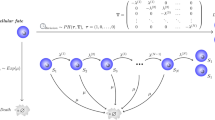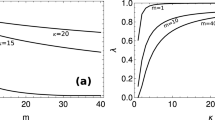Abstract
Smith and Martin1,2 proposed the transition probability (TP) model to explain the significance of the variability of the cell cycle length of individual cells within a clone or culture. This postulates that the cell cycle length consists of a fixed period of time, which is the same for all members of the population, plus a variable period which is distributed according to a negative exponential function among the individual cell cycles. This variable part is contained entirely within G1, may be controlled hormonally by the organism, and is assumed to result from a single first order random process that terminates the variable part of the cell cycle with constant probability. As originally proposed, the model failed to account for timing of the fastest third of the population3. Minor and Smith4 assumed that there is biological variability in the previously presumed constant part of the cycle and that this variability accounts for the failure to see an abrupt discontinuity. They proposed that most of this kind of variation can be cancelled out by comparing sister cells. Thus, they proposed a second plot to test their model, the β-plot. This is a two-cycle semi-logarithmic plot of the percentage of sister-sister cells having a smaller difference in age at division than the time value corresponding to the abscissa of the graph. Their model predicts a straight line starting at 100% at time zero. Any model would require this value at time zero, but theirs requires that the plot be straight and parallel to the terminal slope of the α-plot. Shields and Smith5 and Shields6 have convincingly shown that for tissue culture cells of both mouse cell lines and Staphylococcus albus, the β-plots are linear for 97–98% of the cell populations and parallel to the α-plots. This has been taken as strong support for the TP model. Recently, in developing computer simulation of a growth controlled (GC) model7, I found that certain properties, such as the linearity of β-plots, are very sensitive to the presence of subpopulations of cells with longer doubling times. My major purpose here is to point out three statistical aspects of the cell cycle that are strongly influenced by growth rate heterogeneity for any model of the cell cycle.
This is a preview of subscription content, access via your institution
Access options
Subscribe to this journal
Receive 51 print issues and online access
$199.00 per year
only $3.90 per issue
Buy this article
- Purchase on Springer Link
- Instant access to full article PDF
Prices may be subject to local taxes which are calculated during checkout
Similar content being viewed by others
References
Smith, J. A. & Martin, L. Proc. natn. Acad. Sci. U.S.A. 70, 1263–1267 (1973).
Smith, J. A. & Martin, L. in Cell Cycle Controls (eds Padilla, G. M., Cameron, I. L. & Zimmerman, A.) 43–60 (Academic, New York, 1974).
Pardee, A. B., Shilo, B.-Z. & Koch, A. L. Cold Spring Harb. Conf. Cell Proliferation 6, 373–392 (1979).
Minor, P. S. & Smith, J. A. Nature 248, 241–243 (1974).
Shields, R. & Smith, J. A. J. cell Physiol. 91, 345–356 (1977).
Shields, R. Nature 273, 755–758 (1978).
Koch, A. L. & Schaechter, M. J. gen. Microbiol. 29, 435–454 (1962).
Powell, E. O. J. gen. Microbiol. 18, 382–417 (1958).
Woldringh, C. L. J. Bact. 125, 248–257 (1976).
Woldringh, C. L., De Jong, M. A., Van en Berg, W. & Koppes, L. J. Bact. 131, 270–299 (1977).
Koch, A. L. J. gen. Microbiol. 43, 1–5 (1966).
Schaechter, M., Williamson, J. P., Hood, J. R. Jr & Koch, A. L. J. gen. Microbiol. 29, 421–434 (1962).
Koch, A. L. Adv. microbial Physiol. 16, 49–98 (1977).
Ecker, R. E. & Kokaisl, G. J. Bact. 98, 1219–1226 (1969).
Newman, C. & Kubitschek, H. E. J. mollec. Biol. 121, 461–471 (1978).
Author information
Authors and Affiliations
Rights and permissions
About this article
Cite this article
Koch, A. Does the variability of the cell cycle result from one or many chance events?. Nature 286, 80–82 (1980). https://doi.org/10.1038/286080a0
Received:
Accepted:
Issue Date:
DOI: https://doi.org/10.1038/286080a0
This article is cited by
-
Cell growth and division: a deterministic/probabilistic model of the cell cycle
Journal of Mathematical Biology (1986)
-
Limitations of cell kinetics in distinguishing cell cycle models
Nature (1981)
-
Cell cycle control — both deterministic and probabilistic?
Nature (1980)
Comments
By submitting a comment you agree to abide by our Terms and Community Guidelines. If you find something abusive or that does not comply with our terms or guidelines please flag it as inappropriate.



